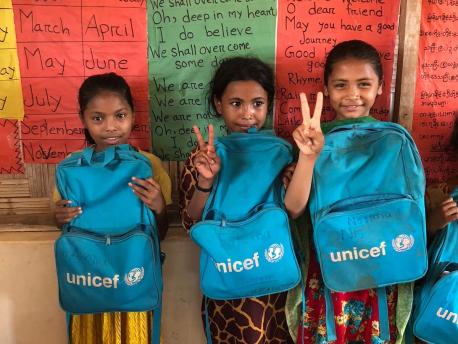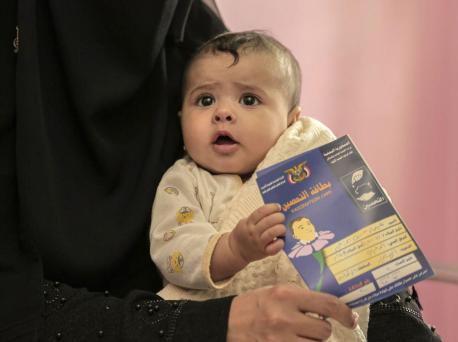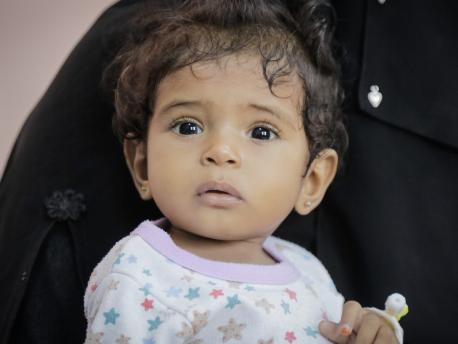
Giving Rohingya Refugee Children a Safe Space to Play and Learn
Balukhali Camp 1 in Cox's Bazar, Bangladesh is part of a sprawling network of tarp-covered shelters housing hundreds of thousands of Rohingya refugees chased out of Myanmar by a wave of mass killings in 2017. Everywhere you look, there is motion. People are walking in every direction, some carrying empty water cans, others carrying cardboard boxes full of just-delivered supplies. Many are empty-handed.
Girls of 10 or 12 balance a naked baby brother or sister on their hip. Everyone is skinny; their suffering shows on their gaunt faces. When a truck pulls up, filled with food rations, a hungry crowd swarms it instantly. The clamor is deafening.
But just inside a makeshift gate of wire and string, there is calm. Three buildings made of bamboo and tarp, a dirt yard. "Hello, how are you?" says Tanzani, the Bengali woman who ushers me inside. "This is UNICEF-supported Child-Friendly Space 1."
Immediately, dozens of children look up and exclaim in unison, "HELLO HOW ARE YOU?"
"I am good! How are you?" I call back.
"I AM FINE!" they yell in unison.

In this small room, there is color everywhere. Hanging from the ceiling are drawings of flowers and houses and English words like "home" and "family" and "peace." Paper horses, elephants, cats and dogs move in the breeze.
There are more than 120 UNICEF-supported Child-Friendly Spaces (CFSs) in the camps. Each CFS looks after anywhere from 70 to 100 children, between the ages of 6 and 12. No adults are allowed in the CFS unless they are dropping off or picking up their children. Adults, especially men, can be a threat.

But in the CFS, children can just be children. They can color, sing, play. They learn the importance of handwashing, and words and phrases and numbers in English. They learn that there are adults who are working to keep them safe and give them the opportunity to thrive.
The center is open from 9 AM to 5 PM, and children are free to come and go throughout the day. Noor, above, wants to be a teacher when she's old enough. Her friend Jasmen plans to be a doctor. Here, they can prepare for a better future.

The goal at the CFS is to help kids recover from the years of persecution they experienced in Myanmar, and the trauma they faced on their journey to Bangladesh.
"At first, many kids are shy," says Tanzani. "They don't do the activities. They don't play with the other kids. But slowly, after time, they open up and you can see the light come back."
The kids smile and giggle as I reach out my hand to shake theirs. The girls point to my earrings and then to theirs. They point to the UNICEF writing on my shirt and then the UNICEF writing on the flag in the main building.
They follow me as I walk around the CFS taking pictures. I ask to take photos of them and they line up and smile and then laugh hysterically when I show them the picture.

Tanzani leads me over to a group of children sitting in the Art Corner. Five or six children are drawing in their notebooks. As soon as I sit, more kids gather around, eager to show me their artwork.
"In the beginning, kids are drawing houses on fire. Machine guns. Helicopters. Images of their family members, who may have died," she says. "Now, they are drawing flowers and houses and maybe the Bangladesh flag." They have seen so much tragedy, but here they smile and laugh. They are safe within this makeshift fence. That's enough for them, for now.
Please support UNICEF's education programs for children in crisis zones around the world.
Sofia Van Raan is a marketing and communications manager at UNICEF USA.
Top photo: In Balukhali Camp 1 in Cox's Bazar, Bangladesh, UNICEF-supported Child-Friendly Spaces give Rohingya refugee children a safe place to play and learn and heal from the trauma they've experienced. All photos by Sofia Van Raan for UNICEF USA.
HOW TO HELP
There are many ways to make a difference
War, famine, poverty, natural disasters — threats to the world's children keep coming. But UNICEF won't stop working to keep children healthy and safe.
UNICEF works in over 190 countries and territories — more places than any other children's organization. UNICEF has the world's largest humanitarian warehouse and, when disaster strikes, can get supplies almost anywhere within 72 hours. Constantly innovating, always advocating for a better world for children, UNICEF works to ensure that every child can grow up healthy, educated, protected and respected.
Would you like to help give all children the opportunity to reach their full potential? There are many ways to get involved.





